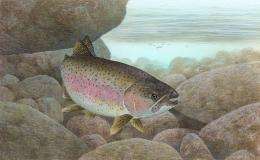July 10, 2012 report
Researchers find cells that move in response to Earth's magnetic field

(Phys.org) -- For nearly half a century scientists have known that some animals are able to navigate using the earth’s magnetic field and for nearly thirty years, it’s been assumed that at least some of those animals that are able to “feel” the weak magnetic field are able to do so because of small amounts of iron material in their tissue. Now, a team of researchers led by Michael Winklhofera of Ludwig-Maximilians-University in Munich, have discovered a way to find individual cells that respond to a magnetic field in one species of migrating fish. As they describe in their paper published in the Proceedings of the National Academy of Sciences, all it took was the introduction of a rotating artificial magnetic field.
Finding the parts of the body that are able to sense a magnetic field, called magnetoreception, has been difficult because of the nature of magnetism. Like sound or light, it strikes the entire body, but unlike the other two stimuli, it can also penetrate the skin and keep on going, meaning receptors could reside virtually anywhere in an organism. Logically though, such receptors would be more likely to reside in the head somewhere, in close proximity to the brain. In migrating fish, the suspicion has been that a good place for such cells would be inside the nose, as fish seem to follow it as they swim.
To find out if this is the case with rainbow trout, the team took a sample of olfactory epithelium from the snout of one such specimen and placed it inside a ring of rotating magnets. Then they looked at the specimen under a microscope and found individual cells that spun around on their axis following the artificially induced magnetic field. Upon closer inspection of the cells, the team found iron-rich crystals, most likely single-domain magnetite sitting at just one end of the cell, very near the membrane; which makes sense. To cause a spin, the magnetite would need to be at the tip of a cell just as it is on the tip of a needle in a compass. Only a few of the cells were found, leading the researchers to estimate that the tissue likely holds just one such cell out of ten thousand capable of responding to a magnetic field.
Of course the finding doesn’t actually prove that the cells are responsible for the fish’s ability to navigate long distances, but it does seem likely to be the case. The trick now will be to show how cells that move in response to a magnetic field are able to convey a message to the brain.
More information: Magnetic characterization of isolated candidate vertebrate magnetoreceptor cells. S.H.K. Eder, H. Cadiou, A. Muhamad, P. A. McNaughton, J. L. Kirschvink, M. Winklhofer. www.pnas.org/cgi/doi/10.1073/pnas.1205653109
Abstract
Over the past 50 y, behavioral experiments have produced a large body of evidence for the existence of a magnetic sense in a wide range of animals. However, the underlying sensory physiology remains poorly understood due to the elusiveness of the magnetosensory structures. Here we present an effective method for isolating and characterizing potential magnetite-based magnetoreceptor cells. In essence, a rotating magnetic field is employed to visually identify, within a dissociated tissue preparation, cells that contain magnetic material by their rotational behavior. As a tissue of choice, we selected trout olfactory epithelium that has been previously suggested to host candidate magnetoreceptor cells. We were able to reproducibly detect magnetic cells and to determine their magnetic dipole moment. The obtained values (4 to 100 fAm2) greatly exceed previous estimates (0.5 fAm2). The magnetism of the cells is due to a μm-sized intracellular structure of iron-rich crystals, most likely single-domain magnetite. In confocal reflectance imaging, these produce bright reflective spots close to the cell membrane. The magnetic inclusions are found to be firmly coupled to the cell membrane, enabling a direct transduction of mechanical stress produced by magnetic torque acting on the cellular dipole in situ. Our results show that the magnetically identified cells clearly meet the physical requirements for a magnetoreceptor capable of rapidly detecting small changes in the external magnetic field. This would also explain interference of ac powerline magnetic fields with magnetoreception, as reported in cattle.
Journal information: Proceedings of the National Academy of Sciences
(c) 2012 Phys.org

















